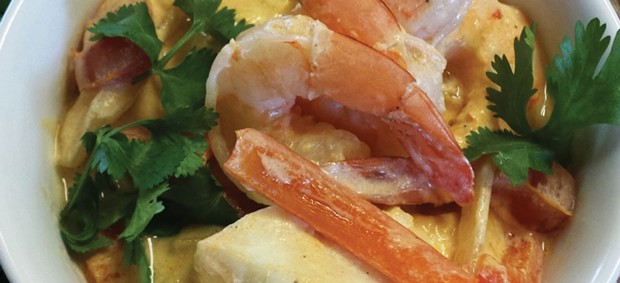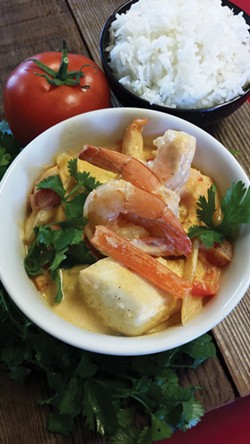[
{
"name": "Top Stories Video Pair",
"insertPoint": "7",
"component": "17087298",
"parentWrapperClass": "fdn-ads-inline-content-block",
"requiredCountToDisplay": "1"
}
]
It was our second evening in Salvador, Bahia, on the coast of Brazil. My husband and I came to Brazil to soak up the music, dance and beaches of Rio de Janeiro and Salvador, but the country also has a rich culinary heritage with dishes influenced by Portuguese, African and indigenous cooking. We had already filled up on churrasco (Brazilian barbecue) and feijoada (black bean stew with pork and cured beef) plus dozens of coxinhas (crispy fried fritters filled with chicken or hearts of palm), so we went in search of a restaurant described in a local magazine as having authentic Bahian food. As we approached, I noticed the adjacent door, which opened up to a staircase, was getting all the foot traffic. Downstairs was a smattering of diners eating more pots of black bean stew. Confused, hungry and deflated, I fumbled to respond to the hostess. She smiled, grabbed a couple of menus and was about seat us, when she suddenly stopped and told us to try the place upstairs if we wanted real Bahian food. I said, "Obrigada!" and ran up the stairs.
On the second floor was a por kilo restaurant where you paid by weight — perfect for curious, hungry visitors — with fried plantains, sautéed collards, grilled fish and garlic rice on the buffet. Amid the bounty, I noticed an aromatic stew with bits of cilantro and red bell peppers. The cashier encouraged me to try it with a sprinkle of farofa, (toasted, seasoned manioc flour) and spicy pepper sauce on top. The dish was called moqueca, a Bahian specialty with coconut milk, fish and prawns. I spooned the moqueca onto some rice and we sat down for our meal just as the sound of the evening's bloco afro percussion shows began in the distance. The harmonious blend of salty caramelized onions, sweet red bell peppers and coconut milk, fresh seafood, earthy palm oil and vibrant cilantro was unforgettable. The stew was velvety yet had a lightness that allowed to me to eat forkful after forkful. It paired wonderfully with my cold Skol beer. I went for a second plate of moqueca despite my husband's headshaking. He knew that my full stomach meant staying out until 4 a.m. to dance my dinner off for a third night in a row. As I paid, the cashier gave me a huge smile and thumbs up. I gave him a thumbs up back for recommending what continues to be my favorite Brazilian dish.
Moqueca
The following recipe comes from watching a Brazilian street vendor make moqueca and an adaptation of a recipe from Brazil, A Cook's Tour, by Christopher Idone. In Brazil, the stew is made in a black clay pot, but I've found that a deep cast-iron skillet or Dutch oven works well. Dende oil or palm oil can be hard to find locally, so annatto oil is a great substitute. You'll have to go online or out of town for farofa. Serves 8.
Ingredients and method:
2 pounds firm whitefish (i.e. halibut, sea bass), cut into 8 steaks, approximately 4 ounces each
2 pounds shelled prawns
¼ cup olive oil
2 medium onions, sliced thinly
½ cup tomato sauce
4 medium diced tomatoes
2 red bell peppers, sliced thinly
4 cups coconut milk
½ bunch of cilantro
½ cup water
Salt and pepper to taste
Dende oil or annatto oil* for drizzling
Preheat the oven to 375 F. Season the fish and shrimp with salt and pepper. In a sauté pan, heat the olive oil over a medium-high burner. Add the onions and sauté them until translucent. Add the tomato sauce and cook it for another minute. Add the chopped tomatoes and red bell peppers. Stir the mixture and cook it for another 5-8 minutes until it thickens. Stir in the coconut milk and water. Place the fish in a lightly oiled, deep cast-iron skillet or glass baking dish. Pour the sauce over the fish and cover it with a lid or aluminum foil. Bake the fish for 10 minutes. After removing it from the oven, place cilantro sprigs over the fish, replace the cover, and bake it for an additional 5 minutes. Add the prawns, placing them in the sauce throughout the pan, and put it back in the oven for an additional 5-7 minutes until all the seafood is cooked. Serve over white rice with a sprinkle of farofa.
*Annatto Oil: Annatto seeds are readily available in most Mexican food markets. Warm 1 cup of vegetable oil in a heavy-bottomed saucepan over medium-low heat. Add ½ cup of annatto seeds and reduce the heat to low. Stir constantly for 3-5 minutes until the oil is reddish orange. Remove the pan from heat and let it cool. Strain the oil into a glass jar with a tight fitting lid. Keep the oil refrigerated for up to two days.

































